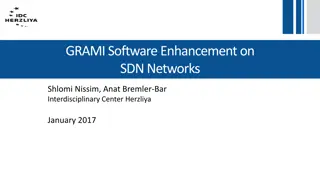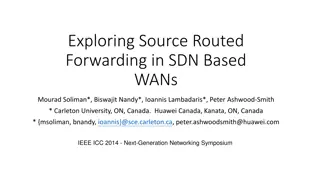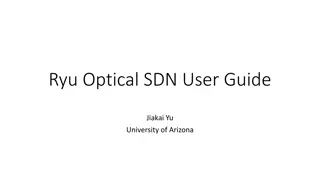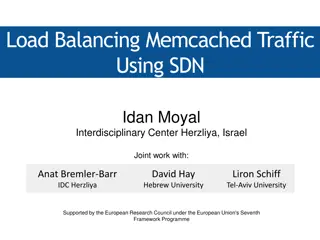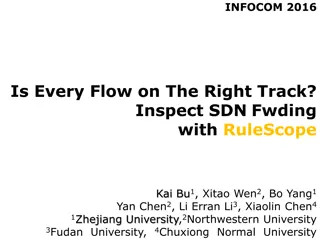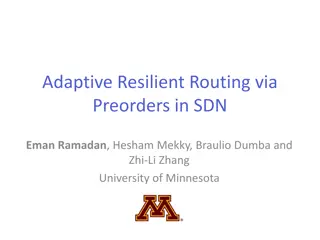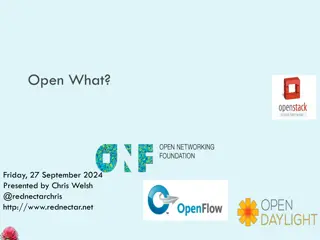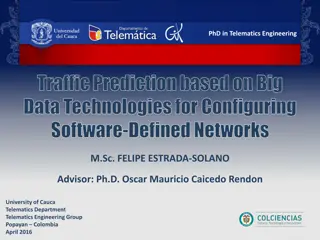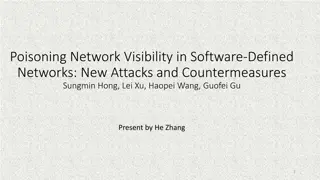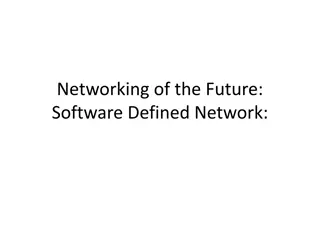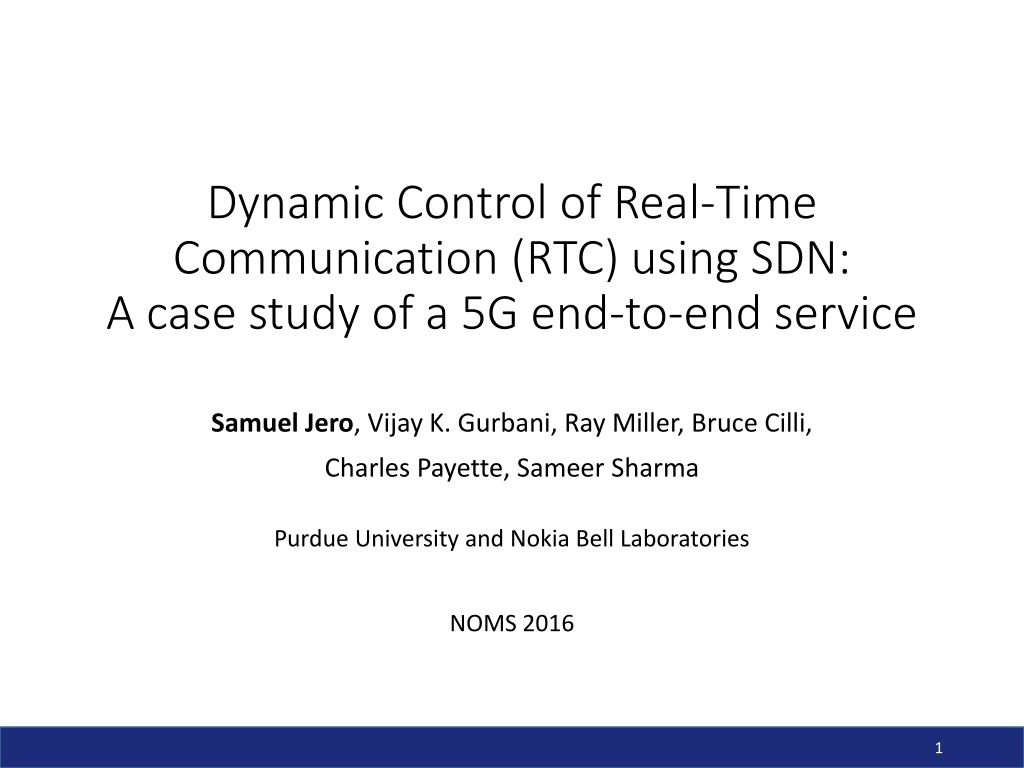
Real-Time Communication Control in 5G Networks
This case study explores the dynamic control of Real-Time Communication (RTC) using Software-Defined Networking (SDN) in the context of 5G services. The discussion covers the increasing demand for bandwidth in mobile networks, the key trends in 5G technology, and the vision of the 5G architecture. The study emphasizes the importance of network adaptability to diverse applications and the role of SDN in centralized network control, focusing on low latency and device-to-device communication. Through an analysis of dynamic network services, such as DNE-RTC, insights are gained to inform the design of future 5G networks.
Download Presentation

Please find below an Image/Link to download the presentation.
The content on the website is provided AS IS for your information and personal use only. It may not be sold, licensed, or shared on other websites without obtaining consent from the author. Download presentation by click this link. If you encounter any issues during the download, it is possible that the publisher has removed the file from their server.
E N D
Presentation Transcript
Dynamic Control of Real-Time Communication (RTC) using SDN: A case study of a 5G end-to-end service Samuel Jero, Vijay K. Gurbani, Ray Miller, Bruce Cilli, Charles Payette, Sameer Sharma Purdue University and Nokia Bell Laboratories NOMS 2016 1
Mobile Networks Faster, better connections than ever before Demand for bandwidth and connectivity continues to grow 69% increase in 2014 560% increase by 2017 Drivers: streaming video, interactive video sessions, data center applications, tactile internet 2
5G: The Next Generation Mobile Network Greatly increased range of applications and requirements Devices: Power-limited sensors, smart phones, tablets, virtual reality, cars, industrial applications, and others Data Rates: sensor data to 8K UHD video Latency: down to sub-millisecond Packet Sizes: tinygrams to jumbograms Key Trends: Network performance indicators will include higher level QoE The network should adapt to the application, not the other way around Flexibility and adaptability are key! 3
Our Vision of the 5G Architecture Application / Business Layer Service Providers Enterprises Tenants Subscribers Services Network Slices Services Layer Analytics Management and Orchestration Orchestration Layer NFV NF-graphs SDN Control Layer Infrastructure Layer Access Technology Core Network Commodity Compute SDN and NFV are be key enablers 4
SDN Centralized control of the network Separation of the Data and Control planes DNE-RTC Low Latency Device to Device SDN Apps Application-plane Northbound API SDN SDN SDN Controller Control-plane Controller Controller Controller Southbound API Switch Switch Switch Devices Data-plane eNodeB Compute Compute 5
Our Work Understand the interactions between the network and dynamic services Dynamic services: services that demand a wide variability in network bandwidth and expectations Approximate a 5G network by introducing an SDN controller into a 4G/LTE testbed Consider an case study dynamic network service: DNE-RTC Identify key takeaways for the design of 5G 6
Outline Motivation 5G Architecture OTT-RTC and NE-RTC DNE-RTC: a dynamic network service The 4G/LTE Network Our proof of concept Implementation Takeaways 7
OTT-RTC and NE-RTC Network enabled webRTC (NE-RTC) webRTC is an OTT service that allows real-time communications between users over the Internet No plugins, no apps Poor video quality and/or extreme latency at sub-100kbps rates Unfair competition: devices in similar network conditions may have rates that differ by > 2x Cell load changes impact random users Network service developed by Bell Labs to provide improved, consistent video call quality Calculates target bitrate for video flows on base station based on SINRs and number of users Provides feedback to device about target bitrate Special radio scheduling algorithm designed for guaranteed bitrate flows Allocates resources across the network to provide desired bitrate Image: https://xenforo.com/community/threads/looking-for-a-webrtc-developer-for-an-open-voice-stream-chatroom.91304/ 8
Dynamic Network Enabled RTC (DNE-RTC) Dynamically enable NE-RTC only when it will be useful for video calls currently in progress Limiting usage of resources to only those times and calls that will benefit Key character of an adaptable network, like 5G DNE-RTC App running on SDN Controller receives device metrics from analytics NE-RTC enabled/disabled based on metrics indicating its usefulness DNE-RTC App = Analytics Setup QoS Target Bitrate Call SDN Controller Start/Stop Device Metrics & eNodeB ctrl v-WebRTC Gateway Routing & QoS Device v-eNB Switch Device Switch RTP and RTCP 9
The 4G/LTE Network Since no 5G testbeds exist yet, we base our proof of concept on a 4G/LTE testbed The 4G/LTE Network consists of a number of interacting components: eNB (eNodeB) or radio base station SGW (Serving Gateway) establishes bearers for data flows PGW (Packet Gateway) policy enforcement and packet routing MME (Mobility Management Entity) key mobility control node PCRF (Policy and Charging Function) sets network policy HSS (Home Subscriber Server) HSS Control-plane PCRF WebRTC Gateway Data-plane MME Video Traffic Device eNB SGW PGW Device RTP and RTCP 10
Our Proof of Concept 5G Network We simulate a 5G network by introducing an SDN controller into a 4G/LTE testbed An OpenFlow adaptor enables SDN Controller to control the eNodeB Adaptor maps between OpenFlow and the base station s CLI commands Sends device throughput info to controller and enables/disables NE- RTC DNE-RTC App New control-plane SDN Existing control-plane Controller Device info & ctrl Call UEID mapping Setup Data-plane Video bitrate cap Start/Stop GBR bearers Video Traffic HSS OpenFlow Adaptor PCRF OpenFlow WebRTC Gateway MME Device eNB SGW PGW Device RTP and RTCP 11
Our Proof of Concept 5G Network DNE-RTC app runs on SDN controller and uses device throughput to decide when to enable or disable NE-RTC App communicates with many existing components: MME to map between different device identifiers PCRF to setup guaranteed bitrate bearers for video flows WebRTC gateway to set target bitrates Device to determine when a call is occurring DNE-RTC App New control-plane SDN Existing control-plane Controller Device info & ctrl Call UEID mapping Setup Data-plane Video bitrate cap Start/Stop GBR bearers Video Traffic HSS OpenFlow Adaptor PCRF OpenFlow WebRTC Gateway MME Device eNB SGW PGW Device RTP and RTCP 12
DNE-RTC App Computes an exponentially weighted moving average of each device s throughput NE-RTC is enabled when the device is in a call and its throughput drops below a low threshold Enables target bitrate computation and scheduling algorithm Sends target bitrate info to WebRTC gateway Sets up guaranteed bitrate bearers across the network A second higher threshold determines when to disable NE-RTC again Disables target bitrate computation and scheduling algorithm Releases guaranteed bitrate bearers for this flow 13
Horizontal SDN interactions are common Mobile Networks are usually separated into a number of domains: RAN, Edge, and Core Network services need to frequently communicate and configure components across all of these domains RAN: base station throughput info and scheduling algorithm Edge/Core: guaranteed bitrate bearers App: target bitrate Thus horizontal communication between controllers in different domains MUST be efficient Core Edge RAN Services 14
Identifier proliferation complicates services The existing 4G/LTE network components use many different identifiers for the same device IMSI, S1APID, IP address, SIP URI Implementing the DNE-RTC service required mapping between 4 of these Hardest part of the implementation Need to minimize the number of identifiers needed in 5G service APIs and enable easy mapping The centralized information and control of SDN will help here 15
Network function graphs have control plane elements Network function graphs provide a way to define services in terms of connected network elements Being standardized by ETSI and IRTF Usually discussed in terms of data plane elements Firewalls, load balancers, IPS, IDS, etc These graphs need to be able to include control plane elements in addition to data plane elements The new components in DNE-RTC are control plane Best Effort Network Function Graph: DNE-RTC Network Function Graph: WebRTC Gateway Internet eNB Device DNE-RTC Controller WebRTC Gateway Internet eNB Device 16
Summary We developed a proof of concept dynamic network service by introducing an SDN controller into a 4G/LTE testbed to study the dynamics of network and service interactions We identified three key takeaways for future work in 5G Horizontal SDN-controller interactions are common Identifier proliferation complicates service development Network function graphs need to be able to contain control plane elements 17
Questions? ?? || /* */ 18









